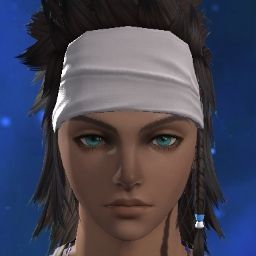Assuming the possibility of whatever systemic revisions I might want, I'd take these.
(Written primarily as teasers for now. I'll cover actual mechanics if asked...)
::Classes relevant
Classes now tend to have better control, utility, versatility, or durability than their respective jobs. Typically at least a couple classes per party outside of progression raid content. Difficult encounters against mechanic-centric enemies may likely include far more. Speedruns may make further use of classes for their enmity or mitigation as to remove the need for a second tank or healer.
Many abilities have been moved from job-only to the class itself (e.g. Stone III, Goring Blade). Many sources of off-role output (such as mitigation on DPS classes) have been buffed. Jobs that go an entirely different direction with the abilities sourced by their class do not replace their class, but are more alike to a second job in the same field that is simply a bit more insular, extending its own style further at the expense of others, than its class.
Certain class mechanics added and/or existing main mechanics made more internally complex and more widely permeative. Certain traits, including these mechanic-centric or -creating ones, may now be cross-classed. Class identity has been therefore expanded, but so have general class versatility and cross-class options. Note: classes no longer necessarily have the same number of traits and/or abilities and jobs may now have traits, allowing for more fine adjustment.
These trait additions can be roughly split into three kinds: Identity-granting, Gameplay-affectors, and Flavor, where each prior set includes the latter factors, the later effects only part of the prior. Identity-granting trait additions are things like Sword and Board for Gladiator, which places all shield abilities and weaponskills on a separate GCD and allows for synergy between the two befitting a shield-user, or Blood of the Dragon (trait) for Dragoon, which passively allows certain actions and effects to empower its Jump and Dive abilities. Gameplay-affectors are ones like Wild Quiver for Archer which gives it something more to strive for during its rotations by timing oGCDs and crits for added haste and crit chance, subtly improving its windowed play and therefore its skill cap. Flavor additions are ones that may indirect increase skill-cap but are done primarily to give that extra 'boost' to gameplay without changing the decisions made during it, such as adding a bit more haste and chaos to Marauder/Warrior through Rampage. More on this later, if necessary.
---------------------------
The Three New Sword-wielders:
Templar, Fencer, and Ronin are all a bit similar in that they are high-skill, high action-rate sword-wielding DPS. Templar uses the western longsword, varying from the length of a bastard sword to a slightly shorter-end greatsword. The Fencer uses the rapier, epee, or similar, and may wield a dagger (typically the main gauche) in its offhand. The Ronin uses the katana, varying from about 39 in / 100 cm to 54 in / 137 cm, and may wield a second katana or a wakizashi in the offhand. The Templar relies most heavily on using its weaponskills in such a way as to manipulate the GCD for either quicker or stronger following strikes (a very different kind of combo-ing), on its direct and indirect stances, and inverted positionals (based on what position the enemy is relative to you, rather than you to it), while the Fencer relies primarily on timing, preparing chains and burst, and coordinated debuffs while maintaining certain levels of personal buffs, and Ronin builds buffs and subsequent loose ability chains through its ability choices such that its rotational choices can push the class into very different gameplay styles or even niches. Templar is probably the most difficult in the short-term, the Fencer in mid-term, and the Ronin in the long-term. Templar is probably also the most difficult overall, and certainly in its one true niche, anti-infantry or especially anti-swordsman. The Mage Knight adjusts and adds to this niche by including anti-caster elements, enabling it to absorb and unleash magic. Ronin tends to fair best against large or diverse monsters, as its various builds allow it to face almost any type of attacker, be it a garlean captain, giant armored boar or divebombing dragon (attackable as it passes), albeit with tremendous foresight. The Fencer's excellent movement into and out of combat range (further enhancable by Rogue's improved Throw Dagger and Lancer's Trammel) and its suppressive attack utility gives it fair survival capabilities against most attackers, and Red Mage's spell arsenal keeps it ready for offense against almost anything.
- Templar > Mage Knight
The Templar stem from an order not so different from the Garleans in that they seek purity even if through force, however their issue lies not with the primals and their end goals with progress and nationalism, but rather with the removal of virtually all magic (or its direct influence upon and use by people) and with more humanistic virtues, and their bond to all nations or none, though they may be forced to ally partly with those nations that house their guildhouses. The Templar consider themselves devout to the 'cause', to their leaders, to their work, and to their training. They live ascetically, and many will take no wives, though they may foster orphans. Though free to retire with age enough to raise a family, many traditionally would continue until their time to do so had well past, often dying in combat or in the guildhalls, old but unbending. This trend, as has the previously equivalent term, 'the human cause', has declined over the last several decades. Leadership has begun to enter into much more lasting arrangements with the 'home nations' (lately called the 'central' or 'father' nations), and entwine itself in politics to ensure the guild's future security. Moreover, their mission in and around their own lands has been nearly completed; nearly all magic, tapable or corruptible, and monsters, the product of such magic, alike, have been cleansed from both their present reality and their inherited legends. Lacking a target fit for the size of its membership, the order's distinction as to harmful and neutral magics has begun to blur, and what was once considered the endless calling of the Templar to cleanse what taint arises is being preempted by striking "at the roots". Devotion to the order itself has become the paramount tenant of the Templar, and their orders far more ambitious. Though stemming from noble reasons, perhaps, the morale and morality of the guild has suffered under these changes, and some would venture even to distant lands to seek out work fit for the goals of the once proud Order, and reconnect with its legacy of old.
The gameplay of the Templar takes immense practice to get used to, probably more than any other job. It has no GCD. In most cases, the Templar's sword never stops moving, one animation blending into the next. Even more foreign, however, is that the sword and ones stance do not necessarily turn completely with the player, its animations and angles neither wholly affected nor independent, allowing it a "positional" element of complexity based upon enemy's position relative to you, rather than you to them, that cannot be cheated by rapid turning, although turning is certainly to be used, to accelerate certain attacks or else build more wind-up before the hit. And last but not least, almost every Templar attack partly includes a parry, and certain of its attacks (it's "guards") are released not on GCD or per queue, but upon the enemy's attack, and others still are actual parries, their "damage" instead mitigating attacks that would hit during the animation. Its weaponskills are all ridiculously simple at face value, little more than geometrical variations (such as the Fall/Oberhau, Cleave/Mittelhau, Rise/Unterhau, Wrath/Zornhau, Crook/Krumphau, Twart/Zwerchhau, Squint/Schielhau, and Part/Scheitelhau), but used in flow they look beautiful. Its parry-traps take a slightly Arthurian or mythic tone, such as through the Unicorn (crests), the Gryphon (crouches), the Rook (descends), the Ox (raises), and the Blade (parts) (TBR).
- Fencer > Red Mage
- Ronin > Samurai
---------------------------
Others:
Pilgrim > Adept
Pilgrims are in many ways the game's most open class, able to take from almost any other, whether physical or magical; they have unique stat crossover between Mind, Intelligence, and Piety and Strength, Dexterity, and Vitality. They are martial staff-users, their combat style a blend between Lancer, Pugilist, and Dark Knight, but with the further addition of attack-blended spells. They tend to be rather hybrid in role, with masterful defensive and attacker-boosting support, and are capable of both ramp-up and burst, depending on their class connections. Animations and rotation depend heavily on Strength/Dexterity balance.
Adepts are simply the next step into actual combat prioritization from Pilgrim. They have slightly fewer crossover opportunities and lesser magical stat crossover, depending further on internal mechanics to ramp up their spells, or else on resources included in their internal mechanics to burst their spells. Their output ceiling is considerably higher than Pilgrim, but their on-demand outputs, especially support, may be reduced. In addition to staves, Adepts are able to use light spears, blade-staves, double-spears, and double-bladed staves, each with a slightly different rotational feel, due especially to internal mechanics that make use of rebound on blunt strikes and cleave on slashing attacks. Their combat style is similar to that of a elementally-aspected (especially to wind) martial artists wielding his/her polearm with near-impossible speed and incredible finesse. Staff-wielding Adepts have the highest-efficiency combination of parry and tumble mechanics in the game.
Adept may choose from a variety of internal mechanics to control output dynamics, such as oaths (ramp-up after an oath is selected, where a certain output level must be met in time to avoid penalties), seals (regenerating burstable buff or nuke resources), chimes (gaining resource from certain types of abilities or effects occurring, even if not their own), and trances (rotations and outputs gradually buff the Adept and aligns him/her with certain elements or styles).
Adept is probably the showiest job in the game, with excellent ramp-up and powerful, supportive openers. It has less weaponskill damage than its line-up, but far more ranged or utility burst that does well in supporting the party through for both survival and dps-checks. Has lower individual dps and provides less direct raid dps than most DPS unless making good use of its utility and being in intensive situations where added mitigation or off-healing (burst or sustain), those things that the supportive elements of other dps lack, may be useful.
---------------------------
Additions to Pre-existing classes:
[Archer] > Ranger
Although the Archer itself has been revised to include more internal mechanics affecting its rotations and include two stances, essentially with and without (a slightly improved) Wanderer's Minuet, Bard has similarly had its song usage and interplay (into proc effects and point-/spot- support opportunities) improved, leaving just enough room for a second DPS pseudo-job, the Ranger. That being said, the Ranger does not purely stem from Archer, nor is it purely a bowman. In many ways it functions more like a class, in that it can take crucial, thematic elements from other classes, such as Beastmaster, Machinist, Arcanist, Conjurer, and Rogue, in addition to Archer, such as for pet use, improved gunnery and ammo, a larger pool of enchant effects, light-wheel synergy, and stealth, respectively, and can additionally equip guns and crossbows. It cannot, however use any of the options available to Archer that do not directly connect to damage dealing or offensive support, such as mitigation tools, healing, defensive support, or, part of the increased cross-class optionality, equipping a small shield for a slight penalty to offense.
The Ranger's animations can vary from fairly subtle to as gaudy as Empyreal Arrow. Their core mechanics are an extension of Archer's and/or Machinist's, modified for weapon type, among Split>Slug>Clean Shots, Wild Quiver, Hawk's Eye (trait), etc, and through either the magic empowerment of the bow, use of specific ammo types, or through sighting, opening, and exploiting weakpoints. The base Archer in Full Draw (the replacement for Wanderer's Minuet) can build up his attacks and crit bonus to the point of dealing an effective 340 direct potency. The Ranger can take that to 500. Machinists can slightly empower their overall damage based on shots fired, with bonuses for those that do not proc, via Hot Shot and the Hot Streak trait. The Ranger can make toast of light enemies with the same. The Archer can dart around trees and the like using the springing attack animation of Windbite. The Ranger can vault over or around small packs of enemies with it. The Archer can equip Hide and increase the critical strike chance and damage of its first attack coming out of stealth. The Ranger can reenter after blinding the enemy or breaking line of sight, gradually boosting crit chance and bonus. Its all more of the same, but truly to an immensely enjoyable extreme.
[Conjurer] > Geomancer
Normally, the water magic of a Conjurer it its healing, and to heal without making use of the surrounding aether is to sap the lifeblood of one's own soul. To the Geomancer, however, water is water. If that water wishes to heal, so be it, but it is far more likely to crash enemies into cliffsides, make mud of the ground beneath them, or outright drown them. Geomancers are high-synergy caster that make use of water, wind, and earth (and indirectly lightning), to devastating effect. However, they are undoubtedly niched, meant for field tactics and mass destruction rather than assassination. Without an Arcanist to change their magics from physical to aetherial form or a White Mage to repurpose the elements involved, it is even possible for them to cause collateral damage, of a sort, among their own forces, by slowing them, washing them away, or blinding them. With such support, however, these broadly offensive tactics can be adjusted into raid-wide support, rejuvenating through storms, fortifying through quakes, and hastening through gales.
--------------------------
Blue Mage and Monster Skills
- Artificer > Blue Mage (not a monster-skill user)
The primary weapon of the artificer are magicked manacles, bracers, vambraces, etc. Resultantly, this job does not actually use a glove slot. There are two ideas behind the power of such things, or technically three: one, they allow you to better transfer the power of body and soul into the power of the world or aether; two, they bind the soul of an aetherial being to you, allowing you to manipulate your power through them or bend their spirit, proportionately to your force, to your will; third, that being claims your soul, and all that can be released from you is now released through their domain. Whichever the case, the artificer is a unique mage of sorts, with a physically-oriented attack style, wearing light, practical clothing, functioning at anywhere from point-blank to mid-long range. Different bracer types provide different pacts, traits through which power is given and its price extolled, in either order, atop other native combat mechanics aligned to different elements. In combat, the artificer is something of a wild card. It tends to be an evasive and durable DPS, but many of Artificer's abilities may leech health from himself for added combat resource or even set himself on fire to deal damage to his surroundings as he fights. In the simplest view, he's a Monk who can punch fireballs and block/absorb lasers. In the healer's view he's usually either a survivor who can handle himself even out away from the party, or else complete hell to heal.
The artificers' Blue Mage, a contemporary revision of an old Sharlayan school of magic based on rewinding, diverting, bending, and returning the essence of one's opponents' attacks, takes this absorption aspect far further. Only, rather than analyzing the enemy attacks patterns and strategy to render it ineffective—or worse, self-injuring—the artificers' Blue mage will literally tear open the aether of an attack, "eat" it, and render it back twofold through self-empowerment and/or a magical release. There are limits to this, of course, and a certain amount of absorbed magic is usually kept in order to protect oneself while absorbing another source. The crucial issue is the gamble as to what will be most effective when, and the requirements to acquire it in time.
Because the Blue Mage must view the world purely and by his own eyes, albeit through an enhanced vision of sorts, the pact between the Blue Mage and his weapon, and the spirit trapped within, is less than that of a typical Artificer. The Blue Mage must not see his spirit as master nor servant, but merely power, its sentience irrelevant.
- Wildling (Monster skill user)
This is my closest approximation of the traditional Blue Mage. It stems from the idea of those who would wonder too deep into the elemental-ruled heart of the Twelveswood, when it was still near its full strength prior to Dalamud's descent. They would allegedly become tempered, mindless, but not quite in the same way as affects the tempered of the primals. The idea of this form of the Wildling is almost like a 'no-god', or 'all-god', tempering, influenced by the fabric beneath things and finding a way through their tempering to tap into that fabric. But in essence, it's really just part original lore, part some ominous lead into a new zone or lore-set, and part excuse for a monster-skill user. The Wildling may use any simple weapon, such a staff, club, short-sword, short spear, hand-axe, or claws, and can enhance these styles through other classes, but its true strength comes from its monster skills. With the attachment of Pugilist or Rogue it may dual-wield, and weapon affinity can be improved through the attachment of any related class.
The ability globe for a Wildling is different than that of other jobs—it is almost entirely based in monster abilities; its abilities can only be enhanced by the abilities of typical jobs and classes that are related somehow to bestial, environmental, or primal aspects, and only those abilities may be enhanced by Wildlings. The Wildling may acquire monster abilities through combat with, defeating, and experience gains within the domains of the related monsters, along with more typical means such as use of related abilities or the completion of related challenges.
The Wildling is by nature a hybrid; its role-composition across its abilities is variable; there are always considerably more ability choices available to the Wildling than he can use at any one time, allowing the Wildling to pick and choose what abilities, exactly, of any role, he wants for a given fight. Certain abilities may have synergetic effects necessary to bring them up to strength and are therefore more ‘packaged’ with others, but plenty can be taken with little consideration other than towards the mechanics they would match in a given fight. This allows the Wildling more freedom than the average class/job, albeit with some limitations.
This extended pool of available abilities is temporary; abilities not slotted fade and are eventually unlearned. Cross-class abilities are unaffected. This fade is based on a mixture of gametime and Eorzean time, and varies with the ability. Fade does not occur while in duty, but the duty’s time will be subtracted after. Cycling through each of one’s different abilities will keep them all up for longer, but gradually any more than you can slot will be clipped, requiring the Wildling to revisit the open world or other environments from which he learned the abilities if he wants to add them back to his ability pool. “Relearning” a given ability early will refresh its duration. Note that this is still purely a bonus though; it’s simply one the one limitation to its oversized available arsenal and subsequent versatility. Or, perhaps one of two; the other is simply that there may not be a direct equivalent ability to certain crucial traditional abilities, such as Provoke.
The typically best classes to have affect Wildling physically are based on the weapon and stat affinity of your monster skills (bear abilities making use of claws, and therefore Pugilist, or high-force attacks, therefore Marauder, while a spine-flinging or goring monster would make use of piercing, therefore Archer and/or Lancer respectively). Its best choices to affect it in internal, rotational mechanics is similarly dependent (whether going for sheer speed due to low per-execute potency range across abilities or for better chaining to really nuke via high per-execute moves, etc.). Its most changing connections, however, are fairly clear: Conjurer (for further light-side elemental wheel access), Monk (Chakra (trait)), Dragoon (Blood of the Dragon (trait)), and Dark Knight (Darkside (trait)).
------------------------------
- Beastmaster
Pretty much exactly what you'd expect. Can use any simple weapon, and may duel-wield if making use of Pugilist or Rogue. Tames beasts. Pet abilities can be triggered from the pet bar or main action bars, and each pet has quite a few. The Beastmaster himself is a fairly durable melee dps, buffed by the pet passively and through its effect-generating attacks and abilities, and buffing his pet in turn through his attacks and abilities. The Beastmaster is in many ways like playing one and a half people at once, if one could comfortably make use of a third hand and eye. Pet and master work in cohesion to create and exploit weaknesses and build buffs aligned to different beast and attack types. Pet swaps are not especially necessary for general combat, as a buff that may correspond to a flying pet (using virtually any attack) will usually have a similarly aspected attack available on even a wolf (Pounce) but can be highly useful where their unique utilities can come into play. These swaps are quick, and the beastmaster may temporarily make use of two pets at a time.
Around the previous level cap, however, the Beastmaster is faced with a major change and, from it, a dilemma. It is possible to sacrifice one's pet to become part of a greater animal spirit, either with greater power and of a particular type, an "old one" or "主", such as a wolf-god or eagle-lord, or one of roughly equal power but able to assume as many types as have been sacrificed to it, "a changeling". From this point onward, both the particular beast-type-related mechanics and the value of synergy across multiple types increase in power and decision-significance. It is possible to play near-optimally, and perhaps even more beneficial in the open world, without sacrificing a single pet, but it is difficult to say what one might do for power...








 Reply With Quote
Reply With Quote








